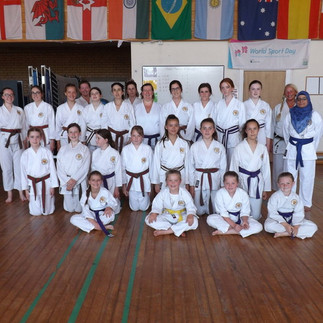Sensei Leigh Simms Course - July 2018
- Sensei David Francis
- Jul 7, 2018
- 4 min read
On an extremely hot and sultry July afternoon in Kempston a very respectable number of students gathered for an eagerly anticipated self-defence course with Sensei Leigh Simms 4th Dan. Renshi made the introduction explaining the afternoon was to be relaxed and informal. He went on to say that some chatting was to be acceptable but try to keep the noise down and remember our etiquette and discipline.
The afternoon’s training began with slow focus training drills which when we grouped up in threes, and in some cases fours, progressed to include zanshin too. Some students may have anticipated a self-defence session similar to many classes in the dojo where maybe one is grabbed to various parts of the arms or body. This was not to be the case. We continued with more training drills and routines, simple yet effective. The moderate pace of the class was excellent considering the temperature in the dojo was over 30 degrees.
The thought behind the session was zanshin (awareness) and the philosophy behind what we were trying to achieve in defending ourselves. Next sensei set up a role play of protecting a child or vulnerable person which was both fun and enlightening for all.
Sensei Leigh Simms explained various legalities as the afternoon progressed but key elements of his words were: -Children are most likely to be attacked by someone they know but for them it’s usually at or around their school. Most violent attacks to females are from loved ones from within one’s own home. Males in their teenage years up to around 30 are more vulnerable away from home and are the group most likely to need self-defence.
In a confrontational situation never stand as if you are entering a freestyle competition. This may be deemed as an aggressive act in itself. It is best to stand in a relaxed stance, like freestyle, but with your hands open and palms down. This is not an aggressive posture and can be viewed as calming body language. The relaxed open handed posture is to manage the distance and set us for a strike; its key purpose isn’t to put us in a place to be ready to block. It's a proactive position, to be ready for whatever may occur.
Renshi has always said that three thing cause you to need self-defence: 1, Possessions (Consider surrendering them, are they worth fighting for?) 2, Arguments and disagreements (why argue? If you appear to agree, even if you do not, and walk away the situation is diffused) 3, You! (By doing the wrong thing, being in the wrong place at the wrong time or by not using zanshin.) Basically if you are not fighting for your life why are you fighting at all? Self-defence is not about fighting.
The theme behind fighting was elaborated on by Sensei Simms. He expanded the thought when referring to “undue or unnecessary force”. The teachings of karate, and other respectable martial arts, is self-defence not necessarily how to fight. In a self-defence scenario one must do just enough to block and counter, preferably to the head or face in some way to disorientate them because should the attacker be under the influence of alcohol or drugs, with adrenaline pumping, they are unlikely to feel pain. The key object is to escape from the attacker(s) and get to a place of safety. Zanshin is paramount here as escaping from an assailant just to get run over by a truck is not desirable at all.
To escape minimising harm to yourself, and your attacker, is good self-defence. To utilise all you have learnt in the dojo is turning the situation into a fight and using undue force is definitely undesirable. This is bad self-defence. Having said that should your assailant have a baseball bat or knife to attack you with, it is acceptable to pick something up (if you can) with which to defend yourself to disarm them and to safely make your escape. Sensei Simms went on to say that even verbal confrontation, threats and aggressive insults may be justifiable cause for self-defence. Should this be the situation, it is acceptable to give a pre-emptive strike. If someone is verbally or physically intimidating, in your face or in your space, they have already committed assault so it is ok to hit out to make your escape to safety but it was repeated not to practice all of your moves on them! It is good practice to give a loud commentary of what is occurring, if people are around, as you may need the support of witnesses should police follow up the incident.
Sensei made a point on getting involved in other people's confrontations and acts of violence even in support of law and order. It may be a good, even moral thing to consider, but is it a wise move? Remember the dojo kun… “Hitotsu Kekki no yu o imashimuru koto”, “To guard against impetuous courage”. Phone the police, was the advice given, stand back, be a witness, and only get involved directly should you absolutely need to.
Sadly the afternoon came to its conclusion too soon. It ended with a question and answer session and everyone receiving an attendance certificate. It was Sensei’s first visit to us but we can promise it will not be his last.
Thank you Sensei for a great afternoon’s training. Well done to everyone who attended.









































Comments